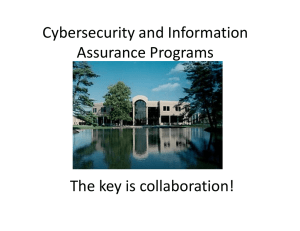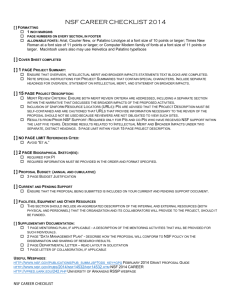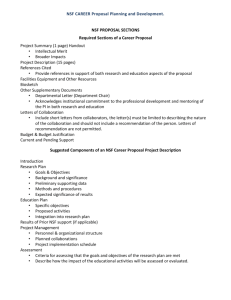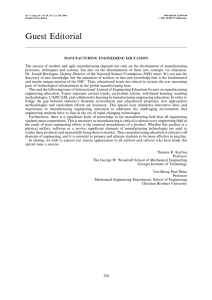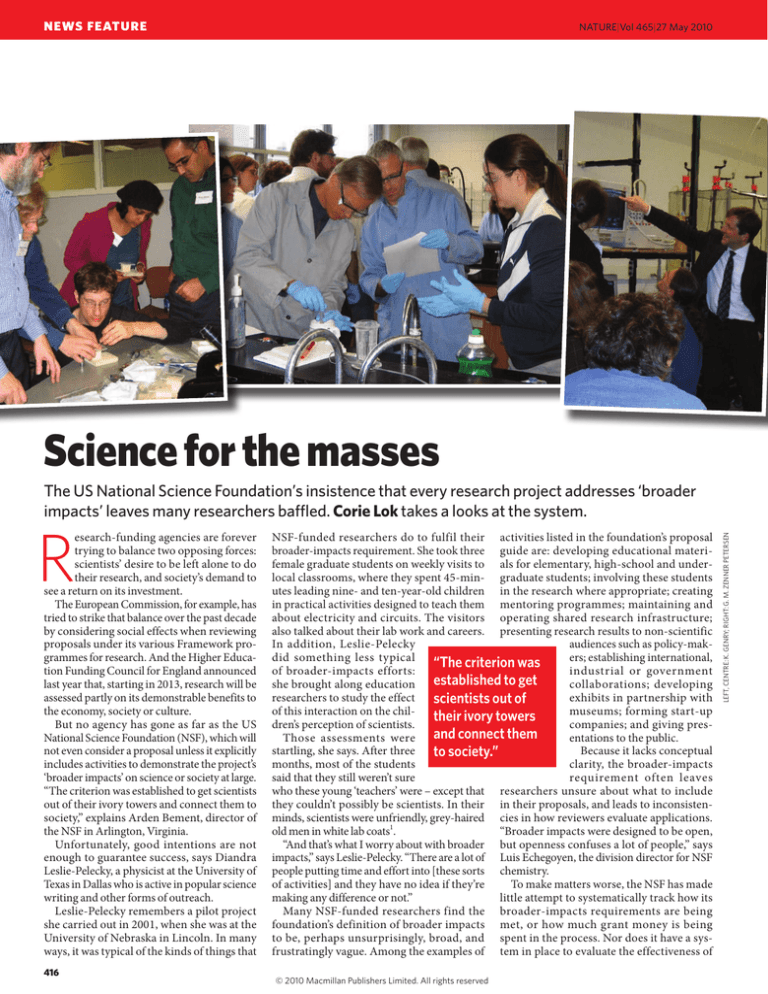
NEWS FEATURE
NATURE|Vol
Vol 465|27 May 2010
Science for the masses
R
esearch-funding agencies are forever
trying to balance two opposing forces:
scientists’ desire to be left alone to do
their research, and society’s demand to
see a return on its investment.
The European Commission, for example, has
tried to strike that balance over the past decade
by considering social effects when reviewing
proposals under its various Framework programmes for research. And the Higher Education Funding Council for England announced
last year that, starting in 2013, research will be
assessed partly on its demonstrable benefits to
the economy, society or culture.
But no agency has gone as far as the US
National Science Foundation (NSF), which will
not even consider a proposal unless it explicitly
includes activities to demonstrate the project’s
‘broader impacts’ on science or society at large.
“The criterion was established to get scientists
out of their ivory towers and connect them to
society,” explains Arden Bement, director of
the NSF in Arlington, Virginia.
Unfortunately, good intentions are not
enough to guarantee success, says Diandra
Leslie-Pelecky, a physicist at the University of
Texas in Dallas who is active in popular science
writing and other forms of outreach.
Leslie-Pelecky remembers a pilot project
she carried out in 2001, when she was at the
University of Nebraska in Lincoln. In many
ways, it was typical of the kinds of things that
416
NSF-funded researchers do to fulfil their activities listed in the foundation’s proposal
broader-impacts requirement. She took three guide are: developing educational materifemale graduate students on weekly visits to als for elementary, high-school and underlocal classrooms, where they spent 45-min- graduate students; involving these students
utes leading nine- and ten-year-old children in the research where appropriate; creating
in practical activities designed to teach them mentoring programmes; maintaining and
about electricity and circuits. The visitors operating shared research infrastructure;
also talked about their lab work and careers. presenting research results to non-scientific
In addition, Leslie-Pelecky
audiences such as policy-makdid something less typical
ers; establishing international,
“The criterion was
of broader-impacts efforts:
industrial or government
established to get
she brought along education
collaborations; developing
researchers to study the effect
exhibits in partnership with
scientists out of
of this interaction on the chilmuseums; forming start-up
their
ivory
towers
dren’s perception of scientists.
companies; and giving presand connect them
Those assessments were
entations to the public.
startling, she says. After three
Because it lacks conceptual
to society.”
months, most of the students
clarity, the broader-impacts
said that they still weren’t sure
requirement often leaves
who these young ‘teachers’ were – except that researchers unsure about what to include
they couldn’t possibly be scientists. In their in their proposals, and leads to inconsistenminds, scientists were unfriendly, grey-haired cies in how reviewers evaluate applications.
old men in white lab coats1.
“Broader impacts were designed to be open,
“And that’s what I worry about with broader but openness confuses a lot of people,” says
impacts,” says Leslie-Pelecky. “There are a lot of Luis Echegoyen, the division director for NSF
people putting time and effort into [these sorts chemistry.
of activities] and they have no idea if they’re
To make matters worse, the NSF has made
making any difference or not.”
little attempt to systematically track how its
Many NSF-funded researchers find the broader-impacts requirements are being
foundation’s definition of broader impacts met, or how much grant money is being
to be, perhaps unsurprisingly, broad, and spent in the process. Nor does it have a sysfrustratingly vague. Among the examples of tem in place to evaluate the effectiveness of
© 2010 Macmillan Publishers Limited. All rights reserved
left, centre: k. genry; right: g. m. zenner petersen
The US National Science Foundation’s insistence that every research project addresses ‘broader
impacts’ leaves many researchers baffled. Corie Lok takes a looks at the system.
NEWS FEATURE
Vol 465|27 May
NATURE|Vol
465|27
2010May 2010
about how their work is connected to enhanc- researchers to maximize the commercial effect
ing benefits to society,” says Robert Mathieu, of their research.
chair of the astronomy department at the UniA preliminary network for broader impacts
versity of Wisconsin–Madison and director already exists. Stanford, for example, has an
of the university’s NSF-funded Center for the Office of Science Outreach, which helped
Integration of Research, Teaching, and Learn- Spakowitz to make the initial contacts
ing (CIRTL). As an example, Mathieu points to to get his project started at the hospital.
the NSF’s prestigious CAREER award for junior And Mathieu’s centre at the University of
faculty members, which requires that applicants Wisconsin–Madison is part of a network
propose educational activities, such as design- of six CIRTLs located at research campuses
ing courses and carrying out public-outreach such as Vanderbilt University in Nashville,
activities, that are integrated with the proposed Tennessee, and Texas A&M University in
research. He has sat on several
College Station. The Wisconreview panels, and says that the
sin centre runs workshops
“It makes scientists
education section of proposals
conducts individual
think more explicitly and
has grown in length and sophisconsultations with faculty
about how their
tication over the years.
members needing assistance
But despite the NSF’s efforts
work is connected to with integrating broaderto educate scientists about
impacts activities into their
enhancing benefits
broader impacts through
grant proposals. The other
to society.”
websites, workshops and
CIRTLs are moving towards
conference sessions, most still
similar sorts of programmes.
approach the criterion with confusion and Mathieu and his group are putting together
dread. Researchers often end up repackaging plans to expand this network to 20–25 uniwhat they’re already doing. “Overwhelmingly,” versities. Their ultimate goal is for any US
Scientists get creative
says Echegoyen, “the number one broader research university that wants its own CIRTL
Nonetheless, there have been some successes. impact that most people in the chemistry to have one, creating a community that shares
At Rensselaer Polytechnic Institute in Troy, division are using is ‘training graduate students best practices among its researchers and
New York, for example, the NSF’s Nanoscale and postdocs.’ ”
other professionals, and develops the experScience and Engineering Center for Directed
One problem is that the kind of support tise to effectively broaden impacts. Mathieu
Assembly of Nanostructures sponsors the network that researchers take for granted — estimates that establishing CIRTLs at the
Molecularium project, which has produced working with collaborators, sharing ideas and nation’s top research universities would cost
teachers’ materials on nanoscience and an advice, learning from published results, attend- roughly US$100 million over five years.
animated three-dimensional IMAX film ing conferences — is still rudimentary when
Yet such ideas lead to a more fundamental
called Molecules to the Max. At the University it comes to broader impacts. A useful model question. Is having every principal investigator
of Wisconsin–Madison, microbial biochemist could be the network of technology-transfer working individually on broader impacts — for
Douglas Weibel and his group have prepared a offices that are found on many US campuses, which many are inexperienced and untrained
child-friendly, interactive display about micro- which have been instrumental in helping — the most efficient way of achieving the maxscopy that they exhibit every year
imum effect?
at the university’s one-day public
Some scholars say no.
science exposition. At Stanford
In a paper published last
University in California, chemiyear, Warren Burggren, a
cal engineer Andrew Spakowitz
biologist and dean of the
spends two to three hours a
College of Arts and Sciweek working with graduate and
ences at the University
undergraduate students to proof North Texas in Denvide workshops for patients at
ton, writes that the job of
Stanford’s Lucile Packard Chilimplementing broader
dren’s Hospital, most of whom
impacts should fall to the
are unable to attend school.
researcher’s institution,
Spakowitz and his group crenot to the researcher him
ate the workshops that cover
or herself 2 . The institutopics such as pH and gravity,
tion, be it college, departand lead the hands-on activiment or centre, would pool
ties at the hospital.
a portion of the NSF grants
Some say that the broaderobtained by its members
impacts criterion has helped
and hire the professionals
to catalyse a change in the
needed to broaden impacts
research-focused culture of
effectively. Scientists should
academic science. “It makes Stanford chemical engineer Andrew Spakowitz (right) teaches children at the Lucile
still be involved, but the
scientists think more explicitly Packard Children’s Hospital as part of his NSF award.
coordination would happen
© 2010 Macmillan Publishers Limited. All rights reserved
417
k. ho, lucile packard children’s hospital
the various projects.
These problems with the broader-impacts
requirement have been confirmed over the
past decade in studies from the National
Academy of Public Administration and elsewhere. In March, the NSF’s oversight body,
the National Science Board, launched a task
force to examine how broader impacts can
be improved. Chaired by Alan Leshner, chief
executive of the American Association for
the Advancement of Science in Washington
DC, the task force is not expected to make its
recommendations until 2011. In the meantime, a small number of academic institutions
are already exploring ways to make broaderimpacts efforts work better.
After all, says Ralph Nuzzo, a chemist and
materials scientist at the University of Illinois
in Urbana–Champaign, most US scientists
have come to accept — even if grudgingly —
that it is probably a good idea to demonstrate
the wider implications of their work. “People
want to do the right thing,” says Nuzzo. “It’s just
hard to know what that is.”
NEWS FEATURE
418
© 2010 Macmillan Publishers Limited. All rights reserved
rensselaer polytech. inst.
at the institutional level. “I
think it will be more efficient, because you’ve got
people doing what they’re
trained for,” says Burggren.
Another idea, suggested by
Barry Bozeman, a sciencepolicy expert at the University of Georgia in Athens, is
for the NSF to create specific
research programmes with
strong broader-impact goals
around areas in which the
effects are important and obvious, such as climate change3.
Bozeman says that the NSF is
already following this strategy
with awards that, for example, Outreach activities such as a board game (left) about the link between nanotechnology and society, and biochemist
promote the recruitment and Douglas Weibel (right) presenting a hands-on microscope display to children, can help bring science to the public.
retention of women in academic
science.
yielded some results, but also showed that perhaps reflects more fundamental issues
The NSF’s broader-impacts requirement the research and the broader-impacts work about the relationship between science and
took its current form in 1997, when the founda- were often so interwoven that it was difficult society, says Britt Holbrook, a philosopher of
tion simplified the criteria used by reviewers to to tease them apart.
science at the University of North Texas. Is the
evaluate proposals. Two of the four criteria —
Mostly, evaluation happens as a by-product NSF ‘passing the buck’ by asking scientists to
the intrinsic scientific merit of the project, and of other NSF activities — routine reviews of meet what is essentially a political goal: demthe soundness of the team’s approach — were grantees’ annual reports, for example, or the onstrating the benefits of science?
merged into one, known as ‘intellectual merit’. regular review of programmes at each divi“My hypothesis is that the NSF has passed
And the other two — the utility or relevance sion carried out by a committee of external some of that burden to the people getting
of the project, and its effect on the infrastruc- scientists.
funded,” says Holbrook, who has a grant
ture of science and engineering
“By not tracking broader- from the foundation to study how different
— were collapsed into ‘broader
impacts activities, the NSF funding agencies incorporate societal impacts
“By not tracking
impacts’.
undervalues its true contribution into their review process. “But when you do
broader-impacts
For the first few years, many
to society,” says Melanie Rob- that, you get push back from the scientific
activities, the NSF
proposers and reviewers ignored
erts, an assistant director at the and engineering community because it goes
this second criterion, treating it
Colorado Initiative in Molecular against the traditional idea of peer review,”
undervalues its
with the same disregard that
Biotechnology at the University which is designed to assess work at a technitrue contribution
they had previously expressed
of Colorado in Boulder who has cal or scientific level.
to society.”
towards ‘utility or relevance’. It
analysed the broader-impacts
And how does the NSF show impact, given
was only in 2002 that the NSF
statements from recent grant that the agency’s specialty, basic research
cracked down, announcing that any proposal abstracts. “It is missing an opportunity to create often doesn’t have an immediate pay-off, or
that didn’t separately address both the intel- a knowledge base of how to carry out broader- else has a pay-off that is difficult to quantify?
lectual-merit and the broader-impacts criteria impacts activities effectively and reward those It’s a delicate balancing act, says Neal Lane, a
would be returned without review.
who do a good job.”
physicist at Rice University in Houston, Texas,
The confusion that persists despite the NSF’s who was the NSF director from 1993 to 1998
The right track
repeated attempts to clarify broader impacts when the broader-impacts criterion was first
Of the few small-scale efforts to track and
implemented. It’s important to get scientists to
assess the broader-impacts requirement, none
think about how their work affects society, he
has been conclusive. In 2008, for example,
says. “But one has to be careful not to push it too
the NSF sent Congress a report on broader
far. If the NSF moves too far in the direction of
impacts, as mandated in the 2007 America
doing things that have short-term benefits, then
COMPETES Act — but included little more
I think that is not consistent with the NSF’s misthan anecdotal descriptions of specific
sion, and that would not be good for American
research projects. The chemistry division
science, engineering and technology.”
■
recently contracted with an outside comCorie Lok is an editor for Nature in Boston,
pany to assess the broader-impacts activities
Massachusetts.
of a sample of its grantees, but the project
1. Buck, g. a. et al. J. Elem. Sci. Educ. 14, 1–10 (2002).
fell into limbo when the company dissolved.
2. Burggren, W. W. Soc. Epistemol. 23, 221 (2009).
And the geosciences directorate carried out
3. Bozeman, B. & Boardman, c. Soc. Epistemol. 23, 183
(2009).
informal surveys of broader-impacts activi- The film Molecules to the Max was created by an
ties in the ocean and Earth sciences, which NSF-funded nanoscience centre.
See Editorial, page 398.
r. nygard; t. dassler
NATURE|Vol
Vol 465|27 May 2010




